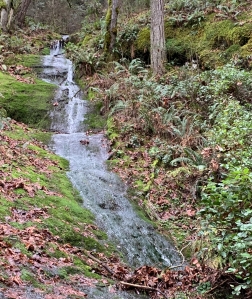
I have spent a bit of time this year on mountain trails. Water travels from one place to another, sometimes with grace and timidity, sometimes with noise and power. It takes the plunge off cliffs. It rolls gently down mountain faces.

When it rains, which it does quite often here, the water travels in more places. It drenches the path worn by the feet of humans and other animals. It flows as it does anywhere else it collects.

The traverse of water is not direct, at least not in the way humans tend to think. It does not cut the shortest path between two points. It meanders. It moves where gravity and momentum pull and push it.

When it encounters a barrier, water sometimes finds another path around and continues its journey forward. Other times, it comes to a halt and must wait until it has built up enough to flow over the barrier. And at yet other times, it is carried with sufficient force—the strength and momentum it has gained—that the water powers over or under the obstacle in its way.

The traverse of water is not direct, but it is efficient and effective. When the rain has stopped, the source has gone dry, or the flow has changed paths, the signs of the waters prior presence remains.




